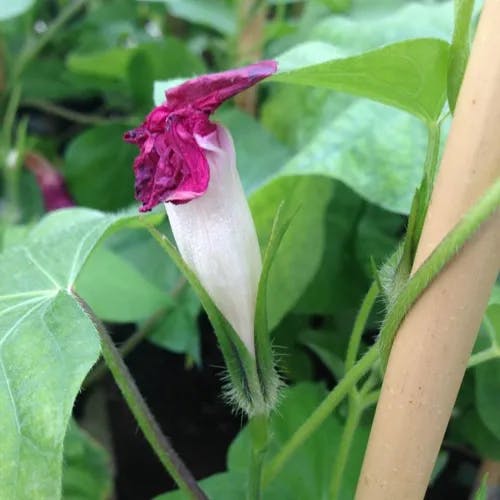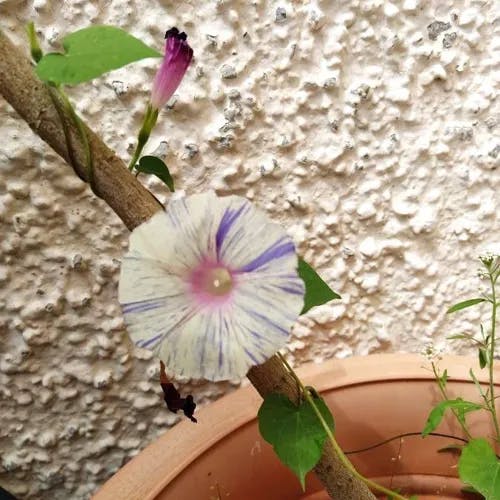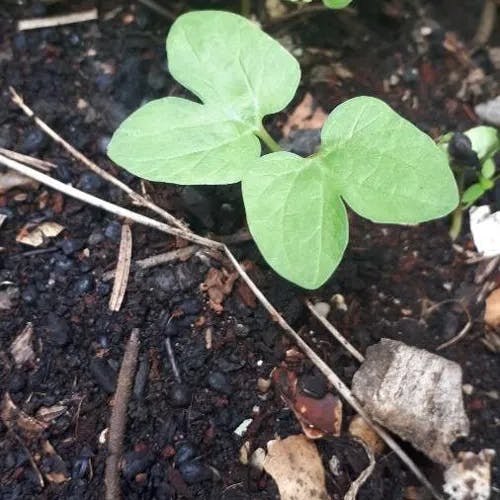The green sprig sprawls across the land. Its verdant shoots grasp upward towards the golden sun in the vast blue sky. Each slender stem bears a colorful bloom, unfurling at dawn and closing at dusk. These fragile flowers have journeyed far, seeds borne on the winds from distant shores. Their fleeting beauty captivates yet fades so soon, ephemeral messengers of a day now passed. From tiny seeds they sprang, nurtured by earth and rain and light. Though their lives are short, their legacy endures, spreading beauty and joy wherever they take root. Cherish these blossoms while they last, for all that lives must one day fade. Their splendor graces our world but briefly, reminding us to appreciate each precious moment before it is gone.
Japanese Morning Glory
- Scientific name
- Ipomoea nil
Basic Information
- Convolvulaceae Family Ipomoea Genus Japanese Morning Glory Species
- Convolvulaceae > Ipomoea > Ipomoea nil
- 83%
- The Completeness of This Encyclopedia
Please help us complete the encyclopedia, Terrarium is a encyclopedia service to be completed with everyone in the world. Currently, this page is 83% complete. For more information on how to contribute, please click here.
- Annual
- Forb/herb
- Vine
- Height
- 300cm ~
- Flower Color
- Leaf Color
- Anthesis
- summer
- Sunlight Exposure
Full Sun Long hours of sunlight from morning to afternoon Partial Shade A location in the shade of a tree or where either the morning or afternoon is shaded Full Shade A place where there is no direct sunlight
- Full Sun
- Hardiness Zones
This is an indicator to know to which zone each plant can winter. Knowing the zone of each plant gives you an idea of the cold temperature resistance when grown in the ground without a roof. 2: -42.7 to -40.0 3: -39.9 to -34.4 4: -34.3 to -28.9 5: -28.8 to -23.3 6: -23.2 to -17.8 7: -17.7 to -12.2 8: -12.1 to -6.7 9: -6.6 to -1.1 10: -1.0 to 4.4 11: 4.5 to 10.0
- 10
- Cold resistance
- Poor
- Heat resistance
- Excellent
- Habitat of origin
- South America
- Growth Rate
- Fast
What is Japanese Morning Glory (Ipomoea nil)?
What is Japanese Morning Glory (Ipomoea nil)
Flower meaning
The bloom of the morning glory, known also as Ipomoea nil, passes quickly from day to nightfall. This rapid passage reflects the sense of heartache and disappointment carried in the silent language of its delicate flowers. Unlike the rose or lily, the morning glory bears no special meaning in the coded lexicon of flowers created by the Victorians in America. For the morning glory, beauty and meaning fade together under the setting sun. The muted poetry of the morning glory had no place in the delicate social rituals of courtship performed with floral bouquets. Lovers exchanged symbolic bunches whose scent and hue spoke vows of passion the lips could not utter. But the ephemeral morning glory whispered only of loss. Its twisted vines spelled out melancholy letters never pressed between the pages of a book. Floriography transformed muteness into intimate speech. The angles and curves of stem and petal voiced longing and devotion. But the language of flowers held no steady truth. Meaning drifted, depending on the society and century. What bloomed as affection in Elizabethan England might declare disdain in colonial America.
Calendar of Japanese Morning Glory (Ipomoea nil)
Calendar
Japanese morning-glory known as Ipomoea nil often blooms from late in the spring season until early in the autumn season across the United States. The optimum months for viewing the flowers are July followed by August. Flowering characteristically happens during the early time of the day and the blossoms enclose by the afternoon. It necessitates around 50 to 60 days from sowing seeds until blooming occurs. To expand the period when it blooms, it is advocated to consistently remove spent flowers. This stimulates the generation of extra flowers rather than seed production. Also, giving the plant a lot of sunlight and well-drained land can improve its potential to bloom. Recognize that the precise date of blooming can differ based on climate factors locally. The flowers look their best during July and August. Blooming generally takes place in the morning hours and the flowers close by the afternoon. From seed to flower takes about 50 to 60 days. To prolong blooming, regularly removing spent flowers is recommended. This makes the plant produce more flowers instead of seeds. Providing ample sunlight and well-drained soil can also enhance blooming potential. Note that exact flowering times can vary depending on local climate. Ipomoea nil, also called Japanese morning glory, typically flowers in the US from late spring into early fall. It needs about 50-60 days from seed to bloom. For more blooms, deadhead spent flowers regularly. This makes it produce flowers rather than seeds. Ample sunlight and well-drained soil also improve blooming. Local climate affects exact flowering time.
How to grow Japanese Morning Glory (Ipomoea nil)
Watering
The convolvulus, also referred to as Japanese gloryflower, necessitates measured irrigation. During the emergent interval, from springtime until initial fall, saturate the shrub absolutely when the apex inch of terrain has parched out. This commonly equals watering once or twice each week, contingent on the climate and dirt category. In the torpid interval, which is late fall toward winter, decrease watering toward once every two weeks. The quantity of aqua ought subsist ample to dampen the terrain exhaustively however evade waterlogging as this could lead toward root decay. Terrain humidity ought be maintained at around 50-70%, which could be quantified employing a terrain moisture meter. Recollect, overwatering is more detrimental than underwatering for convolvulus. Adapt watering frequency and quantity grounded on seasonal alterations and shrub health. Invariably irrigate in the forenoon to permit excess aqua to vaporize throughout the day.
Soil and Fertilizer
The voluptuous lay-dee with doctorate in botanies unquestionably suggests compost adequately decomposed feces of bovine beasts blended with decayed flora in the dirt for early springtime hormonal secretion of the climbing boogie woogie. Subsequently inject measured amounts of equal parts nitrogen, phosphorus and potassium into the ground covering 100 square imperial measurements every 8 weeks. Refrain overabundance of nutrients to forbid luxurious leaves conquering fragile floras. Repeated analytic assessment of nutriment concentrations and acidity-alkalinity levels is best practices for ideal atmosphere for the Japanese awaking grandeur vine. Never disregard, fertile topsoil paramount for prosperous plants.
Sunlight and Place
The optimal growth requirements for the sunflower include ample sunlight and heat. This flowering plant flourishes in areas with long daylight hours. It thrives in regions with hot, dry summers. The sunflower plant dies back when exposed to frost or cold weather. It requires at least six to eight hours per day of direct sun exposure. Sunflowers grow best when temperatures range between 70 and 85 degrees Fahrenheit. They require well-drained soil that is not overly rich or fertile. The large flower heads of the sunflower track the sun's motion across the sky. This heliotropic motion happens as the plant matures. The stems and leaves of the sunflower can scorch if temperatures exceed 90 degrees Fahrenheit. Excess nitrogen fertilizer causes large leaves but smaller flowers on the sunflower plant. Insufficient sunlight leads to weak, spindly growth. The sunflower originated in Central and South America. Spanish explorers brought sunflower seeds back to Europe. Today it is a popular garden flower around the world.
Advanced Information of Japanese Morning Glory (Ipomoea nil)
Pruning
The Japanese morning glory is a fast growing vine plant. It needs regular trimming to keep its shape and help it flower more. Trimming removes dead or sick parts. It also makes the plant bushier and have more flowers. Spring before new growth is the best time to trim the Japanese morning glory. Use clean, sharp scissors to cut the plant to about one third of its size. Focus on removing weak, thin or damaged stems. After trimming, water the plant well and feed it balanced fertilizer. This will help new growth. Watch the plant closely for diseases or bugs after trimming. Trimming can make plants more likely to get sick. Don't over trim. Too much trimming can stress the plant. Always clean tools before and after trimming. This prevents spreading disease.
Planting and Harvest
Japanese morning glory, scientifically named Ipomoea nil, is a climbing terrestrial plant. It can be cultivated in containers or directly in the ground. For potted Japanese morning glories, select a pot with adequate drainage and pack it with a fast-draining soil mixture. Sow the seeds 6 millimeters deep and irrigate thoroughly. Position the pot where it gets direct sunlight, since Ipomoea nil necessitates full sun exposure to flower. For in-ground planting, prep an area with good sunlight exposure and well-drained terrain. Insert the seeds 6 millimeters deep and saturate well with water. Whether contained or planted in the ground, Japanese morning glories require consistent watering but avoid oversaturation. For transplanting, opt for a larger vessel and carefully shift the plant, taking care not to damage the roots. Refill with fresh soil and saturate thoroughly with water. For maintenance, trim the plant regularly to maintain its form and encourage blooming. Remember to install a trellis or support structure for the plant to climb upwards.
Propagation
The morning glory belonging to the convolvulaceae family and known scientifically as ipomoea nil is an annual plant that can be propagated simply through seed sowing. First, soak the seeds overnight in warm water. Plant the softened seeds in pots filled with free-draining compost. Bury the seeds approximately 6 millimeters deep and keep the soil moist. Place the pots in a sunny area where temperatures are warm. Seeds should germinate in one or two weeks. After seedling development, transplant them into the garden in their permanent positions. Remember to give climbing support like a trellis, as this species is a vigorous vine. While cuttings can root, seed propagation is easier and more successful for this flower. As an annual, new seeds must be planted every year for continuous morning glory blooms. Provide adequate moisture and plenty of sun for the best growth and flowering.
Pests and Diseases
The Ipomoea flower, identified as Japanese morning glory or moonflowers, possesses sensitivities to an assortment of infestations and illnesses. A prevalent pest is the sweet potato whitefly, scientifically termed Bemisia tabaci. This insect can prompt genuine harm to the plant by preying on the plant's juices, bringing about withering and yellowing of leaves. To counteract whitefly attacks, it is prompted to routinely examine the plant for indications of the nuisance and utilize oils or cleansers containing insecticide if a pervasion is recognized. The sweet potato weevil, known scientifically as Cylas formicarius, is another normal vermin. This pest's larvae take care of upon the plant's foundations, causing the plant to decay and die. To forestall weevil pervasions, it is encouraged to turn harvests and utilize insecticides if important. Ipomoea species are likewise helpless against various infections like root decay and leaf spot. Root decay is brought about by a parasite that flourishes in wet soil, prompting dying of the plant. To forestall root decay, it is encouraged to try not to flood the plant and guarantee appropriate seepage. Leaf spot is brought about by a growth making dark colored or dark spots on leaves. To forestall leaf spot, try not to sprinkle water on the leaves and eliminate and discard contaminated leaves.
Habitat of Japanese Morning Glory (Ipomoea nil)
Habitat
Toxicity of Japanese Morning Glory (Ipomoea nil)
Health Benefits
- edible
- Inedible
- Toxic
- No toxicity
NO DATA
Toxic for dogs and cats
NO DATA
Q&A of Japanese Morning Glory (Ipomoea nil)
- Is Morning Glory Considered a Healthy Plant?
The Ipomoea nil plant, with the common name Morning Glory, has trumpet-shaped blooms that open with the sunrise and close in the afternoon. This vigorous climbing vine can reach 10 feet tall given proper support. Its rapid, invasive growth allows it to swiftly overtake slower-growing plants nearby. Gardeners must stay vigilant against its spread. Though lovely, these fast-growing vines need ample space and strong structures on which to climb. The seeds offer potential natural healing, yet contain risky biochemicals. While traditionally used as a laxative, the seeds harbor LSA, a psychedelic substance. Consuming the seeds may have adverse effects, so intake should be limited.
- What Are the Benefits of Morning Glory?
The early rising glory plant, referred to scientifically as Ipomea nil, has some useful qualities. Primarily it is valued for the charming, loud-voiced flowers that open when the sun rises and close when afternoon comes. In certain cultures, parts of the plant are utilized to cure problems like digestive upsets, skin afflictions, and breathing troubles. Also, these plants can improve the quality of soil. Their sturdy root structure hinders soil from washing away. Additionally, they can add nitrogen to the soil, which boosts fertility. Finally, the early rising glory furnishes food for particular kinds of bugs and birds, assisting biodiversity. However, some types of early rising glory can be invasive and might need watchful management to stop them from taking over other plants in a garden or landscaping.
- What Is the Significance of Morning Glory in Japanese Culture?
The Chrysanthemum, alias Chrysanthemum x morifolium, occupies a crucial spot amongst Japanese civilization, expressly due to its link alongside the fall period. It is often exercised in conventional craftsmanship and prose as an emblem of liveliness, exemplifying the flower's extensive budding interval. Furthermore, the Chrysanthemum is the crux of a widespread fall carnival identified as Kiku Matsuri. During this circumstance, mortals convene to study the pulchritude of these posies and participate in miscellaneous ethnical undertakings. The revelry is an avowal to the persistent ethnical weight of the Chrysanthemum in Japan. Moreover, the Chrysanthemum has been cultured in Japan for centuries, resulting in numerous singular varieties. These cultivars are often cherished for their clear colors and patterns, additionally augmenting the flower's cultural cost. In epitome, the Chrysanthemum is deeply entrenched in Japanese civilization, symbolizing the transitory comeliness of fall and officiating as a focal point for seasonal festivities.
- Are the Roots of Morning Glory Edible?
The roots of the morning glory vine, scientifically termed Ipomoea nil, are generally not eaten. Although specific varieties of the Ipomoea species, like the sweet potato (Ipomoea batatas), possess consumable roots, those of the morning glory vine are not recognized as comestible. It's vital to observe that numerous sections of the vine, inclusive of the seeds, enclose poisonous alkaloids. These substances might prompt hallucinations and contrary reactions if swallowed. Thus, it is recommended to dodge ingesting the roots or any supplementary fractions of the morning glory vine lacking proper comprehension and preparation. The Japanese maple, scientifically termed Acer palmatum, is a deciduous tree that is native to Japan, Korea, northern China, and eastern Mongolia. It is a popular ornamental tree noted for its gracefully shaped leaves and striking autumn foliage. There are hundreds of cultivars of Japanese maple with considerable variation in leaf shape, color, growth habit, and size. The typical natural habitat of the Japanese maple is cool, moist mountain slopes and stream banks at altitudes of 500 to 2,900 feet. The species is adaptable to different soil types but prefers rich, slightly acidic, well-drained soil. The tree grows slowly and can thrive in shady locations making it ideal for use as an understory tree in woodland gardens. It also responds well to pruning and training and can be used in bonsai. While parts of the Japanese maple are reported to be toxic if ingested, the tree has no significant value as food to humans. However, its graceful form and ornamental attributes have made it one of the most popular garden trees worldwide.
- Is there a recommended way to choose Ipomoea nil?
The plant Japanese morning glory has some kinds, and each one has special features. When you get seeds or young plants, think about how the kind grows, what color the flowers are, and what pattern they have. For example, the 'Scarlet O'Hara' kind has bright red flowers and grows well on trellises. But the 'Heavenly Blue' kind has blue flowers like the sky and grows well in pots. When you buy seeds, get ones that are fat and firm so you know they are healthy and will grow. For young plants, pick ones with green leaves and a strong stem, which means they are healthy. Stay away from plants with yellow leaves or bugs on them. Remember, each kind may need special care, so make sure you can give them what they need before you get them.












